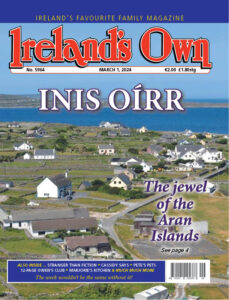Carina McNally takes us on a tour of the smallest of the Aran Islands and looks at a new book by photographer Mike O’Flanagan which offers a unique documentation of the island from the 1970s to the present day in photographic form.
The Irish island of Inis Oírr is renowned for its captivating beauty. The smallest of the Aran Islands, it is approximately 3km by 2km in size. The islanders live mainly on the eastern side of the island and the main language spoken Irish. With a resident population of around 290 people it is divided into five main settlements each with their own unique identity; one such place, Baile an Lurgáin (Lurgan Village) is named after Loch Lurgan an ancient name for Galway Bay, which according to tradition was once an enclosed inland lake.
Inis Oírr lies approximately 8km from Doolin in County Clare. The most easterly of the Aran Islands lies amongst its Aran sisters Inis Mór and Inis Meáin off the coasts of Connemara in West Galway and County Clare, alongside a number of smaller uninhabited islands.
 Over the years, the smallest Aran has been known by various names – Inis Thiar, Inisheer, Inishere and Inis Oirthir. However the names all have one thing in common – they are an anglicisation of the Irish Inis Oirthear, meaning eastern island. It is now known officially as Inis Oírr.
Over the years, the smallest Aran has been known by various names – Inis Thiar, Inisheer, Inishere and Inis Oirthir. However the names all have one thing in common – they are an anglicisation of the Irish Inis Oirthear, meaning eastern island. It is now known officially as Inis Oírr.
The islands terrain, a karst limestone pavement, in reality, is an extension of the landscape of the nearby Clare Burren. A sandy place with very little natural soil, for hundreds of years islanders created, through hard work and creative laboured processes, the striking small fields of Inis Oírr still so impressive today.
Limestone was broken up, spread on the ground and overlaid by layers of seaweed mixtures. Then, sand and any natural island soil available was laid on top and a new soil created. The then broken-up limestone rocks were used to build a beautiful series of dry stone walls to make boundaries between the created fields. Such field-making is still undertaken by the islanders to this day.
Continue reading in this week’s Ireland’s Own


